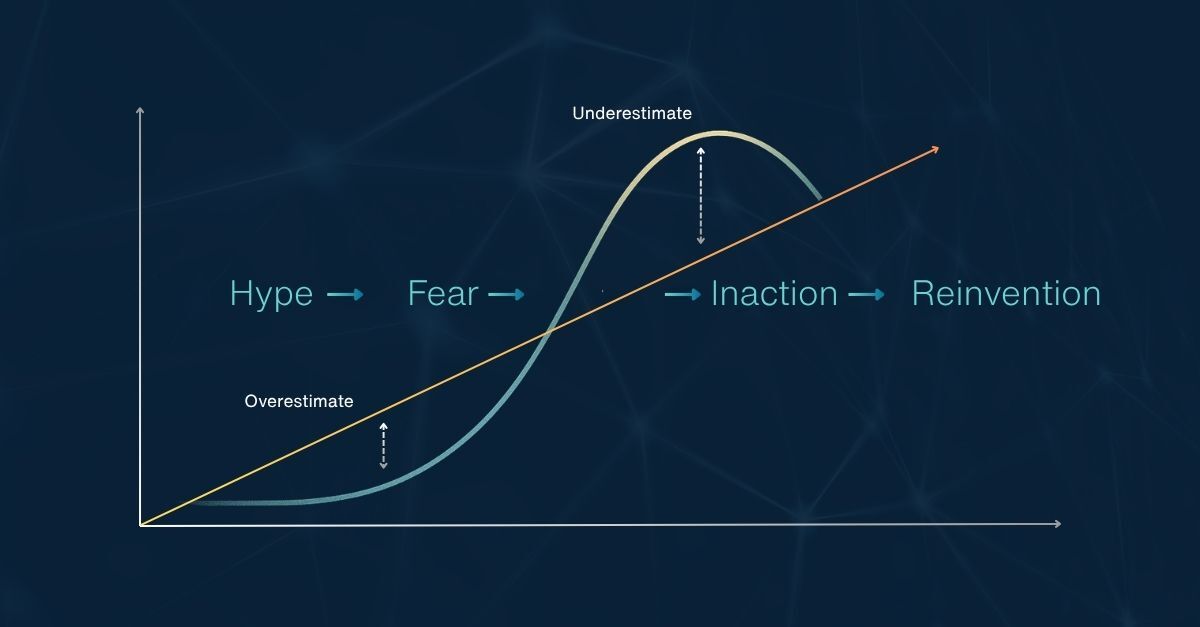1 min read
Amara’s Law and the Fear That Stalls Banking’s Future
Key Takeaways From This Blog: Each wave of innovation, online banking, mobile, now AI, follows the same cycle: hype, hesitation, and eventual...
Navigate this high stakes process with precision.
A solution delivering fast, efficient, and accurate core data.
Digital solutions to grow, scale, and outperform.
Reliable, efficient, and integrated core platforms deliver results.
Select modern communications channels to integrate with core and digital solutions.
Strategic Planning
Support services for the strategic planning process at every level.
M&A Planning
Realize the key value drivers resulting from your merger or acquisition.
Performance Benchmarking
Tailored metrics and benchmarks designed to assess relationships.
Organizational Efficiency
Enhance efficiency across branches, digital channels, and contact centers.
A digital library of industry news, analysis, best practices, and thought leadership tailored to the challenges and opportunities faced by financial institutions.
Our in-depth analysis of conversion strategies, M&A activity, and the evolving landscape of financial services.
A podcast channel for the time-constrained banking professional delivering sharp insights on fintech, strategy, and leadership to help you stay ahead in a fast-changing financial world.
For 360fi Workflow clients only. Sign in to access the workflow library and other guides, forms, and tutorials.
4 min read
 Joe Dugan
:
10/24/25 10:44 AM
Joe Dugan
:
10/24/25 10:44 AM

Key Takeaways From This Blog:
The Spark That Started It All
When Chime and Marcus burst onto the scene, the industry took notice. Chime built a digital-first banking experience that felt effortless and inclusive. Marcus, launched by Goldman Sachs, married simplicity with the credibility of a global institution. Both drew millions of customers and billions in deposits in only a few years.
Their success was magnetic. Community and regional banks saw a blueprint: launch a digital brand, offer attractive rates, and gather deposits without adding branches. It was an exciting idea. Technology had finally matured. The barriers to entry were low. The appeal of reaching new customers beyond local markets without adding additional brick and mortars was hard to resist. Across the country, dozens of banks and credit unions set out to create their own digital brands using the Field of Dreams model. Except when they built it, not many deposits came.
The Reality Check
A few years later, while Chime and Marcus reached scale, most community and regional bank digital brands have struggled to do the same. Independent data show that among roughly 40 U.S. institutions under $25 billion in assets that launched digital divisions after 2018, fewer than one in five surpassed $500 million in deposits. Most plateaued well below $200 million. The majority remain active but small, often attracting balances from existing customers rather than new ones.
Why Most Didn’t Take Off
Comprehensive Digital Strategy
There lacked a clearly defined digital business strategy, one that encompasses the role that digital plays in serving community banks’ traditional customers and their separate brands’ digital-only customers. In other words, one strategy for the entire digital ecosystem that is interdependent and delivers the mission, vision, and values of the enterprise collectively, regardless of division, brand, or subsidiary.
Awareness Customers cannot choose what they do not know. National players like Chime and SoFi invest hundreds of millions of dollars in marketing every year. Community banks often expect brand awareness to spread organically.
Differentiation Many new digital brands launched with identical messages: great rates, no fees, and modern technology. Without a distinct purpose or audience, one looks just like another.
Internal Cannibalization A portion of “new” deposits often comes from existing customers who move funds from other accounts inside the same bank. The totals rise on paper but not in the market.
Rate Chasing Attractive rates can drive temporary spikes, but these balances tend to leave when the next high-yield offer appears elsewhere.
Economics of Scale Even when deposits reach hundreds of millions, the cost of technology, compliance, and marketing remains high. The hoped-for funding advantage can evaporate.
What the Data Says
An event study of FDIC Call Report data between 2016 and 2025 shows no significant difference in deposit growth between banks that launched digital brands and those that did not. On average, banks grew deposits about six percent per year before launching and at nearly the same rate after. That pattern suggests the digital brand itself rarely changes the growth curve.
Still, There Are Bright Spots
Not every story ends quietly.
· Rising Bank from Midwest BankCentre gathered more than $100 million in deposits in its first few months and became a learning lab for its parent.
· Greenpenny, launched by Decorah Bank & Trust, has built a loyal base among customers who want their money to fund renewable projects.
· ZYNLO Bank by PeoplesBank continues to innovate digital lending and payments.
These examples show that success is possible when the brand connects to a purpose or a market niche within the context of the parent bank’s enterprise digital strategy rather than an independent vertical competing on rate alone.
The Ingredients of a Successful Digital Brand
The lessons from both successes and struggles are clear. A digital brand can work, but not as a shortcut to growth. It must be built on purpose and scale, and it must be fully integrated into the enterprise’s comprehensive digital strategy with the following in mind:
A Smarter Way Forward
For community and regional banks, the lesson is not “don’t build a digital brand.” The lesson is “build one for the right reasons.” Technology alone does not create growth. Differentiation, purpose, and disciplined marketing do. Digital brands can still open new doors if they express what makes a bank truly distinctive and if they earn a reputation for authenticity, not just convenience.
A digital brand can be a growth engine when it solves a real problem for a defined audience.

1 min read
Key Takeaways From This Blog: Each wave of innovation, online banking, mobile, now AI, follows the same cycle: hype, hesitation, and eventual...

Key Takeaways From This Blog: The Universal Banker is evolving into a digital, real-time advisor powered by AI, instant payment rails, and...

When I’m helping Engage fi clients develop their digital strategies, the first question I ask is simple: